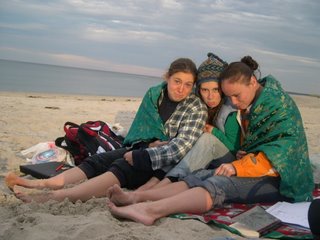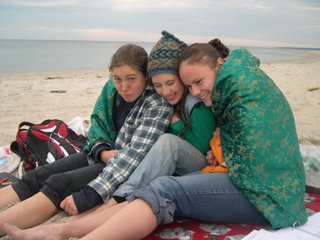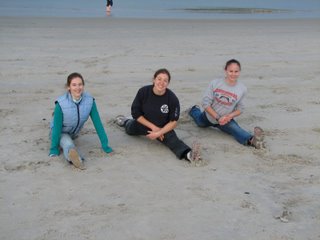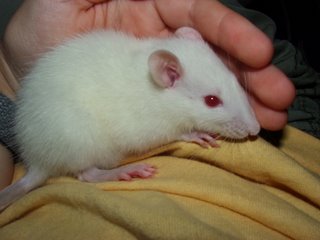Dec 4, 2006
extra terrestrials
Think carefully. This is peaceful, which means the aliens are not in any way trying to hurt you or Earth. (But they could, out of kindness or misunderstanding. If you've ever read Speaker for the Dead, there's a good example in that book of how what is highest honor to one species could be death to another.)
Would you be moved by the one-ness of life if the aliens were humanoid like us? If they had legs and arms and heads and made noises to communicate and saw in the visible spectrum with eyes? Would it fill you with a sense of understanding about the order of things in the universe?
Or, would you think it was more beautiful if they were completely different? What if they're not even made of carbon? Could they be metallic? Or silicates? Would you decide that humans are truly special and unique, and be thankful that chance (or God, I suppose) allowed us to be the way we are? Would you collapse at the feet of entropy?
Maybe you would see the aliens and realize just how unevolved we are. Maybe they are near-perfect machines. Maybe they aren't machines at all - maybe their bodies are useless and their brains are everything. Maybe they don't even have bodies.
What would you want their senses to be? Do you wish they could see in the visible spectrum so you could take them to your favorite place and show them how beautiful Earth is? Do you wish they saw in x-ray or infrared or something else, so they could tell you about the world you can't see? Should they be able to hear sound? Should they have sense we don't have? What if they feel cosmic rays pounding through their bodies? What if they feel emotions like we feel force?
What do you want them to think about us? Should they marvel at us? Should they be disgusted? Should they be confused? Why?
What would you say to the alien? What would you tell them about Earth?
Earth is the sacred and the profane. We are children of paradox.
ugh.
Monday isn't looking any better.
Neither is Tuesday...
Dec 2, 2006
Oct 29, 2006
orange
I’m eating an orange shortly after waking on quiet Sunday morning. Outside the sun is bright and cold, and the leaves are falling like rain in a strong wind. Inside it’s still quite chilly, and I’m wrapped in thick blanket.
I don’t like the white rind underneath the tougher orange rind. I have to peel it off, strip by strip until the orange is bruised and the juice runs down my fingers and makes the hangnails sting. That’s good. It means the orange is perfectly ripe. I’m sitting by myself at the kitchen table. I’ve spread out paper towels over a wide area, and placed a bowl on either end. The left one is for rinds; the right one is for finished sections.
Peeling the orange takes at least half an hour and it’s not a painless process. My nails are too short to get each piece of rind, and so I must resort to a series of different knives, each carefully wielded so as not to puncture the fruit. Nevertheless, the juice drips down my wrists and gets my watch band sticky.
When the orange is finally ready I arrange the slices in the right hand bowl. I pick up the paper towel and the bowl of rinds and throw them away. At the sink I stand with my hands under the warm running water for far longer than is necessary, letting the warmth in to my bones. When I decide I’m wasting water, I allow myself twenty more seconds and I count down slowly, and then turn the water off.
Back at the table I sit cross-legged in the chair and arrange the blanket around my shoulders. I pick up a slice. My lips are cracked from the dry weather, and from smiling, and they sting with each bite, but the flavor is unsurpassed. More juice drips down my wrists. Between the third and fourth slices I wash my hands again. When the last section is gone I wipe down the table with a sponge and wash my face with hot water. I shove my hands in to my pockets and wrap the blanket around me and stand in the doorway to the kitchen, smiling. The room smells sharp and citrusy and the sun is weaving patterns on the table. My mouth still stings with flavor.
Oct 26, 2006
cool topology puzzle

The puzzle is in this picture. How can the two shapes in the box in the upper left be the same? Topologically speaking, they are *not different*.
So how does that work? You could look at my drawing, but it sucks, so I made a video of how you convert between one shape and the other using silly putty. The rules: you can't break anything, or disconnect and reconnect anything, and there must always be the same number of holes in the object you are manipulating (in this case, it's a double-holed donut). You are allowed to stretch and shrink the material as much as you want as long as you don't change the fundamental properties of the shape.
Video is here!
Oct 21, 2006
symphony
And in the Dvorak the cellos are swaying to their own beautiful melody; the orchestra looks like a colony of corals in a warm ocean current. The piccolo is the flashing of the small fish in the sunlight and the low brass and basses are the ocean floor itself.
It ends in a flurry of dancing, you're supposed to be swinging in the moonlight, arm in arm, spinning as fast as you can without falling over. The audience claps and the orchestra sounds like a herd of buffalo. The maestro bows three times and finally the lights dim on the stage.
Downstairs everybody is singing their favorite parts, putting away their instruments, polishing them, cleaning them, putting on their coats and smiling because they can't stop; because their faces have been smiling for so long and they are so full of nervous energy and so exhausted from the performance that they can't smooth out their muscles. We tell each other it went well and climb the stairs to the lobby where there the audience is waiting. Our friends meet us. They gives us hugs and shake our hands and we stand around talking about the music. Then we walk home in the storm outside, wind whipping our hair.
Oct 15, 2006
how your body adjusts your hearing
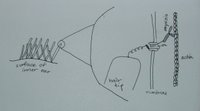 Here's the set up of your inner ear. The tiny little hairs (cilia) in your ear each have a tiny spring attached to the top. When the hairs move around, due to sound waves, the spring stretches, and pulls open an ion gate on a neuron. Ca2+ flows in, and an impulse is sent to your brain, and you hear a noise.
Here's the set up of your inner ear. The tiny little hairs (cilia) in your ear each have a tiny spring attached to the top. When the hairs move around, due to sound waves, the spring stretches, and pulls open an ion gate on a neuron. Ca2+ flows in, and an impulse is sent to your brain, and you hear a noise. (like this picture shows)
(like this picture shows) If the sounds you are hearing are too loud, or too soft, your inner ear makes an adjustment. The end of the spring is attached to that critical ion gate, right? So depending on how far away the tip of the hair is from the ion gate, there will be different tension in the spring, and it will take different amounts of force from sound waves to cause the ion gate to be pulled open.
If the sounds you are hearing are too loud, or too soft, your inner ear makes an adjustment. The end of the spring is attached to that critical ion gate, right? So depending on how far away the tip of the hair is from the ion gate, there will be different tension in the spring, and it will take different amounts of force from sound waves to cause the ion gate to be pulled open.Your body takes advantage of this. When it's really loud, your body moves the ion gate closer (by way of myosin and actin) so that only a HUGE, powerful sound wave can put enough tension on the spring to cause you to hear. This is why you go deaf after a party or a rock concert. If it's really quiet, your body increases the tension in the spring by moving the ion gate far away, so a tiny force is enough to trigger hearing. That's why you hear so well in the morning!
Oct 13, 2006
Pull for the Shore
Pull for the Shore
Wilbur sits by the front window. He is wearing his down parka that says ‘1972 Olympics’ on the front. Perched on his head is his oldest ski hat. He is leaning over stiffly, trying to tie his heavy winter boots through thick leather mittens. His skier’s body is frail and desiccated. He is getting ready to go home.
He’s sure he remembers his home; a haven in a hazy mind. It was so recently – maybe yesterday or last week - that he was a young man and he'd ski through the freezing
Barbara appears before his chair. He loves her very much; but he’s confused. She could be his mother, his wife, his sister, his child. She asks him why he's wearing those winter clothes, and points outside to the green trees and overgrown lawn. He says he wants to go skiing when he gets home. Barbara holds his shaking hand and asks him where he thinks he’s going. He tells her that he’s going home to
He takes off his hat slowly, reaching up in the air and finding the tassel. He worries immediately that once he gets outside it will be too cold. Barbara leans down and unties his boots and slips them off his feet. She shakes her head slightly at his two layers of woolen socks, but she lets him keep his leather mittens.
Wilbur looks out the window at the sky. A small grey arrow shoots through the sky and behind it, the blue sky turns an puffy white. He marvels at the strange things the sky can do, condensing itself in to these fantastic structures. He hears a loud buzzing noise as the structure grows longer. He’s glad to be safe from that power, at his home in his velvet chair.
Back in the kitchen Barbara has made 3 pies. There’s apple, in to the crust of which she has carved a heart, mincemeat, full of raisins and spice, and pumpkin, for which she is whipping cream. Her children are all with her. The oldest stands at the sink with her hands in soapy water. The youngest is drying dishes. The other two are quiet, watching her add sugar and vanilla to the cream.
Barbara has seen this day coming. She’s disappointed that it came when he still sometimes knew her name, still could whisper ‘good enough’ in response to ‘how are you feeling today?’. She’s crushed that it had to come at all, that somehow her strength was just not enough for the two of them, and that he’ll be gone in a few hours, leaving the house so empty.
She adds more sugar to the cream. One of her daughters is covering the pies in tin foil and carefully packing them in to a canvas bag. Grandchildren drift in, see her tears, and exit uncomfortably. She tries to tell herself there was no other way; and she goes through the days in her head.
On Thursday she woke up from a nap and he wasn’t in his chair, nor on the couch. She tore through the house, thought he might have fallen down in the street, or walked in to somebody else’s home – and then she found him, asleep in the grass, under the maple in the front yard. When she woke him up he didn’t remember which house was his.
Then it was 2 days later that he came with her to the store, and exhaustion overwhelmed him in the baking aisle. His knees shaking, his face in shame, he sat down and she couldn’t help him up. To be stranded at this routine errand, calling for help down 20 feet of sugar and flour...
Just yesterday he’d forgotten her entirely. He was worried that the fire in the stove would go out, and despite her reassurances that there was no fire, and everything was electric these days, he insisted that his wife would be unhappy if it were too cold. She held his hand and told him gently that she was his wife, and that there was nothing to worry about. He looked sincere and lost, shivering under blankets in the July heat.
And there’s the constant struggle to keep his failing body alive. He can barely feed himself, his muscles are wasting away under the Olympic parka, and his blue eyes are lost in wrinkles. She barely sleeps at night, lying awake waiting for him, to help him sit up, and steady his arm as he shuffles to the bathroom or gets a drink of water.
So there he is, in his parka, out there by the window. It breaks his heart that he’ll never ski again, and hers that he will sit in an unfamiliar hall with some young nurse who will help him lift forkfuls of those pies to his mouth, who will say to him, sing-song, ‘Wilbur, you must be such a sweetheart, look at all these presents!’. He will stumble further in to his thicket, far from any clearing of consciousness, until he is unreachable except by desperate methods of sweets and music. She knows she will see him sitting by the piano in that big hall, with the parka on, inexplicably moved by a song he can’t remember.
Barbara finishes whipping the cream and rises out of her reverie. The kitchen is warm and full of good smells. Her children surround her, carrying the canvas bag with the pies, and together they walk in to the front room where Wilbur is sitting. The grandchildren come, too, once they muster the courage to see his sad eyes and her tears.
Barbara sits across from Wilbur again. She tells him she’ll help him with his tennis shoes if he’s ready to leave, but he’s so comfortable, he can’t think why he’d be leaving home. ‘Where are we going?’, he asks. She says they're going to a place where everybody is trying very hard to help him be comfortable and well. Wilbur is sorry to hear that somebody is sick, but he tells her that he is ‘good enough’. He’ll be ok in the velvet chair.
She asks him if he'd like to bring his book of crossword puzzles to do in the afternoon. He nods gently and he smiles a little. He rises from the chair, elbows and knees shaking under his feather weight. Somebody is helping him up from behind and 'thank you' rises mechanically to his lips from a lifetime of sincere gratitude. An arm is on his shoulder. A blue velvet pillow to match his chair is pressed in to his hand. He sees a child in front of him holding a plate of cookies. The girl says ‘Grampa, it's your favorite kind.’
Somebody begins playing his favorite song, 'Pull for the Shore,' on the piano, and a flute and many voices join in. He stands there, stooped, in front of his chair, and listens. Beside him his children and grandchildren are watching his eyes.
‘Light in the darkness, sailor, day is at hand!
See o’er the foaming billows fair haven’s land,
Drear was the voyage, sailor, now almost o’er,
Safe within the life boat, sailor, pull for the shore.
Pull for the shore, sailor, pull for the shore!
Heed not the rolling waves, but bend to the oar;
Safe in the life boat, sailor, cling to self no more!
Leave the poor old stranded wreck, and pull for the shore.’1
The tune swells to the refrain and Wilbur’s lips once again begin to move. ‘Safe in the life boat, sailor, cling to self no more’, he whispers, as the others stand around him and sing. ‘Leave the poor old stranded wreck and pull for the shore’. He holds Barbara’s hand and she leads him out the door. The air rushes in as the storm door swings open, and it’s a sweet summer day. He steps along the walk, brick by brick. The others surround him as he eases in to the car seat, and a hand presses his seat belt in to place. He feels the engine of the car start and somebody rolls down his window and shuts the door. Everyone is still singing. The song fades away as the car backs in to the street, and Wilbur gets ready for the voyage, and thinks of how happy he will be, at home, when it is over.
1. Words and Music by Philip Bliss.
Oct 1, 2006
basic theory review
1. 700: Gregorian chant. Gregory is important because, although he didn't write any of the chant named after him, he collected and organized the many kinds of chant all around Europe in to the Ordo. Most of these chants were modal melodies.
2. 900: Guido D'Arezzo invents solfege and modal theory! Also, notation comes in to use.
3. Age of the crusades: violins are brought to Europe from the Middle East. Great cathedrals are built around Europe and organum comes in to practice (organum is an early form of polyphonic music, usually, the main melody was just translated down a 5th). There are several kinds of chant: Oblique (1 moving line and 1 drone), Parallel (like organum), and Contrary (counterpoint as we know it). Universities are built, double-entry book keeping and capitalism arise (I STILL don't know what this has to do with music).
4. By the Renaissance, Palestrina is composing. His music is studied by Johann Fux, who then writes the book "Gradus ad Parnassum" (Parnassus is the mountain where the muses live). This book categorizes Palestrina's music in to "species" of counterpoint. Counterpoint is defined as "the art of combining melodies that sound good together".
Counterpoint:
1. First species: notes are 1-against-1. Only consonances allowed (unison, 3rd, 5th, 5th, octave, 10th). Must start on 5th or octave, and end on octave. Can't have 2 skips in a row, no parallel 5ths or 4ths.
2. Second species: 1 line has twice as many notes as the other (half notes on whole note). Accented beats must have only consonances, unaccented beats may have dissonances but only if they are prepared and resolved by step.
3. Third species: 4 notes on 1 (quarter notes on whole note). We didn't do this one.
4. Fourth species: uses tons of suspensions. Can lapse in to 2nd species if necessary. Still can not jump to or from a dissonance.
Rhythmic Types:
1. Compound triple meter (circle with dot) - 9/8 time signatures, example: Jesu Joy of Man's Desiring
2. Simple triple meter (circle) - 3/4 time signature, example: Home On The Range
3. Compound duple meter (half circle with dot) - 6/8 and 12/8 time signatures, example: d minor partita for solo violin, Gigue movement, by Bach
4. Simple duple meter (half circle) - 2/4 and 4/4 time signatures, example: Pomp and Circumstance
Multimeter:
1. Rhythmic patterns such as " 123 123 12, 123 123 12" which repeat, and are therefore regular, but are not made out of homogeneous units, example: "America" from West Side Story.
2. Or, rhythmic patters such as "1234 123 12345 1234567 12 123" which do not repeat and are not regular, example: "The Firebird".
Polymeter:
1. 2 regular meters that happen at the same time. For example, a pattern of 3 beats against a pattern of 2 beats, where each pattern takes the same length of time. One hand goes "1, 2" and the other hand goes "1, 2, 3". It sounds like: "do do-n-do" (1, 2(from triple)-2(from duple) 3).
Melodic Types:
1. Conjunct, like "Ode to Joy", with few jumps
2. Disjunct, like "The Star Spangled Banner", with lots of jumps
3. Phrasing: antecedent consequent phrasing, when the first phrase ends on a V chord, and the second phrase echoes the first in melody and length but ends on a I. Examples: "Oh Susannah", "My Bonnie", and "Home on the Range".
Musical Textures:
1. Monophonic - only 1 melodic line, no harmony or counterpoint, examples: Gregorian chant, somebody whistling
2. Homophonic - 1 dominant melody with supporting harmony that has approximately the same rhythm, examples: traditional church hymns, a singer who is playing chords on a guitar to accompany himself
3. Polyphonic - contrapuntal music, rounds, canons, fugues (think Bach!), with more than 1 melody at once, example: "To The Greenwood", "One Day More" from Les Mis,
4. Heterophonic - rare in Western music!, 1 melody only, but simultaneous variations on it are happening
Musical Timbres:
1. Homogeneous - like a chorus, where everybody is creating one blended sound
2. Heterogeneous - like a rock band, where each person sounds very distinct
Scales:
1. The major scale (diatonic): interval structure goes like this: WWhWWWh where W = whole step and h = half step.
2. The modes
a. Starting on "re": Dorian (WhWWWhW)
b. Starting on "mi": Phrygian (hWWWhWW)
c. Starting on "fa": Lydian (WWWhWWh)
d. Starting on "sol": Mixolydian (WWhWWhW)
e. Starting on "la": Aeolian (WhWWhWW)
f. Starting on "ti": Locrian (however, in common practice tonal music this is not used)
3. If you omit the half steps ("fa" and "ti") you get a pentatonic scale. You can do this in any mode.
4. Other words to describe scales:
a. Hexatonic - 6 pitches
b. Heptatonic - 7 pitches
c. Octatonic - scale alternating between whole and half steps, there are two of these
d. Anhemitonic - scale containing no half steps
e. Chromatic - scale with only half steps
f. Whole tone - scale with only whole steps
5. Scale degree names: tonic, supertonic, mediant, subdominant, dominant, submediant or superdominant, leading.
Chords:
1. In a major scale: I, ii, iii, IV, V, vi, viio.
2. In a minor scale: i, ii0, III, iv, V(w/ raised leading tone), VI, VII.
3. Chord inversion:
a. For a triad: root position, 6 chord, 6/4 chord.
b. For a 7th chord: root position, 6/5 chord, 4/3 chord, 4/2 chord.
4. Diminished triad: m3, m3. Augmented triad: M3, M3. Major triad: M3, m3. Minor triad: m3, M3.
Circle of Fifths:
1. A fifths progression played on the piano comes out with the following chords: I, IV, vii, III, vi, ii, V, I. In C major the base line goes C, F, B, E, F, D, G, C.
2. The true circle of 5ths in major keys (go down a minor third to get relative minor): C, G, D, A, E, B, F#, Db, Ab, Eb, Bb, F. You get it backwards if you start in C and go by 4ths.
Random Useful Information:
1. There are 7 half steps in a perfect 5th.
2. Plagal music is centered around sol of the key (like "Happy Birthday"). Authentic music is centered around do (like "Ode to Joy").
3. Components of a cantata (meaning "sung"): recitative, aria, chorus, and chorale.
Sep 30, 2006
seriously now
If you were disappointed to read in the New York Times last week that the Iraq war is costing approximately $1 billion per week, or that we have spent nearly $330 billion already... think about going.
If you were embarassed to hear President Bush say that "the stability we thought we saw in the Middle East was a mirage"... think about going.
If you were disappointed yesterday to read that wiretaps in the US no longer require a warrant... think about going.
If you were horrified to read that the Senate passed a bill that disallows terror suspects the right of Habeus Corpus... think about going.
This protest is run, in part, by the American Communists. Is that scary? You decide - maybe you hate communists. But here's what I think: I think that waiting to find an organization who exactly represents your beliefs before you act is dangerous. It's unlikely to happen, and I believe in the name of this protest - the world can't wait any longer for change. Just because you attend a protest or event associated with a particular party doesn't make you a member.
I'm not sure what I'll think about the protest. In general I'm afraid of crowd mentality and I don't do well in large groups. But I think it's worth it to go. It's worth it to put yourself in to an uncomfortable situation in order to catalyze change.
A lot of people critizise the American left for knowing who they are against (Bush!) but not knowing what they are for. In many cases I find this to be a valid criticism - sometimes it's just not useful to complain unless you an offer a better alternative.
But in some cases, when your government is torturing prisoners or slowly removing the rights of its own people, there's no time to sit tight and think. We can't wait until we know exactly what will happen next.
This has to stop.
Sep 19, 2006
Sep 18, 2006
semiconductors!
At the moment I'm having problems with the images I wanted to put in the document, so it might be frustrating to read at the moment. I'll have it fixed soon.
Sep 16, 2006
Sep 13, 2006
the imcomparable awesomeness of hemoglobin
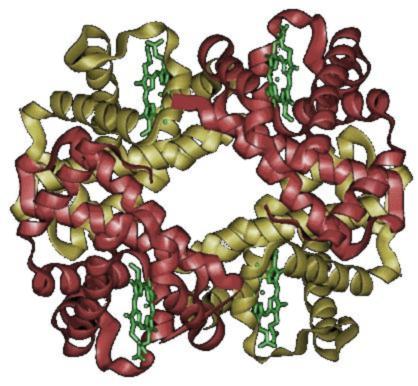
Folks, meet hemoglobin. Hemoglobin is a tetrameric protein. That means it's made out of 4 subunits. In this case, its subunits are called alpha, alpha, beta and beta. The two alphas and the two betas are identical.

Hemoglobin is reponsible for carrying the oxygen you breathe in to the cells throughout your body, via your bloodstream, so that your cells can carry out respiration and you can stay alive. How it accomplishes this task is.... wicked awesome.
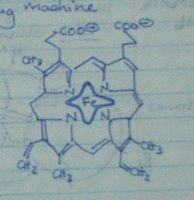 Here's another very important part of hemoglobin. It's called a "heme group", and although it's not a protein itself, one lies in the middle of each subunit. That means there are 4 heme groups per protein.
Here's another very important part of hemoglobin. It's called a "heme group", and although it's not a protein itself, one lies in the middle of each subunit. That means there are 4 heme groups per protein.The most special part about the heme group is the middle. There's a space there for 1 single iron atom to bind. You can see it in the picture. (Iron = Fe.) This iron atom is the critical, important part of the whole entire protein. You'll see why.
So, let's follow the path of an oxygen molecule. It gets breathed in, and it's hanging out in the alveoli, which are the little sacs at the very end of all the crazy trees that make up your lungs. Then hemoglobin comes swishing by in a capillary that goes by the alveoli. The oxygen molecule diffuses through the wall of the alveoli (don't worry right now about how that works), and it binds to the iron atom sitting in the middle of the heme group. That's the important part.
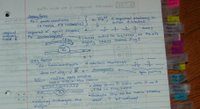 Normally, iron atoms, unbound (Fe2+), have a certain size. They're pretty big. (If you want more details, it's because there are 4 unpaired electrons in the outer d orbitals of the atom. All of these atoms have the same spin, and that makes the atom paramagnetic.) What you need to know is that the iron atom is SO big, it doesn't quite fit in to the hole in the middle of the heme. It sticks out the top.
Normally, iron atoms, unbound (Fe2+), have a certain size. They're pretty big. (If you want more details, it's because there are 4 unpaired electrons in the outer d orbitals of the atom. All of these atoms have the same spin, and that makes the atom paramagnetic.) What you need to know is that the iron atom is SO big, it doesn't quite fit in to the hole in the middle of the heme. It sticks out the top. But when the iron atom binds the oxygen molecule you breathed in, it becomes smaller. (This is because the electrons reorganize in the d orbitals, and the spins now cancel each other out, and the atom becomes diamagnetic. Incidentally, this rearrangement from high energy orbitals to lower ones causes the red color of iron and blood.) Now, the iron atom fits in the hole in the middle of the heme *perfectly*.
Why does this matter? Because when the atom shrinks down, a particular part of the hemoglobin protein that sits next to it gets pulled down too. (It's Histadine 8 on the F chain, by the way.) Although it may not seem like pulling one small arm of a very large protein would make any difference it does!!
 In fact, it makes a very large difference. It causes the subunits of hemoglobin to change positions with respect to each other. The subunits kind of look like dumbells, and they rotate 15 degrees from a nice even X shape (like the crossbones on a pirate flag) to an uneven X. (This change in shape happens when 8 hydrogen bonds and some salt bridges are broken.)
In fact, it makes a very large difference. It causes the subunits of hemoglobin to change positions with respect to each other. The subunits kind of look like dumbells, and they rotate 15 degrees from a nice even X shape (like the crossbones on a pirate flag) to an uneven X. (This change in shape happens when 8 hydrogen bonds and some salt bridges are broken.)So the protein is a slightly different shape. Why do we care?
Now, this is the COOLEST part. The pressure of oxygen in your lungs is about 100 mmHg. The pressure of oxygen in your body tissues is about 30 mmHg. If you don't know about mmHg, it doesn't matter. All you need to know is that there's more oxygen in your lungs than in your tissues. Naturally, right? Remember, you just breathed in.
In the 100 mmHg areas in your lungs, it just so happens that the oxygen-bound/small-atom/uneven-X form of hemoglobin is quite stable. That's good! That means that when hemoglobin is around high concentrations of oxygen, it wants to bind it. (This is because molecules always end up in the most stable state possible.)
But hemoglobin is special, because it's sensitive to the difference between 100 mmHg and 30 mmHg. At 30 mmHg, the stability I described is no longer the case. In fact, it's more stable NOT being bound to oxygen. So the oxygen is going to fall off. This is absolutely essential. It means that when the hemoglobin shows up in your tissues in your body, where you have low oxygen pressure, the oxygen falls off. Hooray! Now your cells can use it.
Sep 11, 2006
disparate thoughts on a strange day
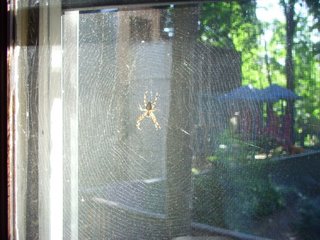 What am I doing posting a picture of a spider web on 9.11?
What am I doing posting a picture of a spider web on 9.11?I'm not sure, either.
But I don't think it's an accident.
I don't like the thought of churning out images of a Connected Mother Earth, where each poor little spider has a Profound Influence on all of us... no, that's not where I'm going. Let's be honest: this spider has very little influence.
I think it's more sobering. 2 generations ago, there was another day like this: 12.7. There are many more: D-Day. April 18, 1775. March 23, 2003. Every brain is pockmarked, each person carrying around a crater caused by some massive death.
What I want to know is this: does this connect us? Do we live in denial of our togetherness until we're forced to huddle together in some dark room and await death? Would we forget why we have countries and boundaries and fights without these catastrophies? Are they teaching us slowly to put aside our differences?
Or are they just another reason to fight?
Aug 30, 2006
Jul 20, 2006
Big sky blue, change your hues, roll your rainbow dead
Raving mage, stem your rage, still your crazy head
Deep sand red, fall to bed, save your wish unsaid
Sun sinks low on mountain eve
A catch rises in your throat
Sun winks slow in a desert weave
Chill blue dark crawling
Big sky blue, change your hues, roll your rainbow dead
Raving mage, stem your rage, still your crazy head
Deep sand red, fall to bed, save your wish unsaid
Blind night lone on mountain peak
Climbs silent towards you
Friend or nemesis, a shriek
Shatters the stifling
Stillness
A lullaby
You hear
Big sky blue, change your hues, roll your rainbow dead
Raving mage, stem your rage, still your crazy head
Deep sand red, fall to bed, save your wish unsaid

